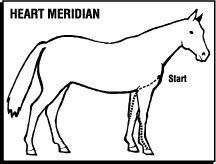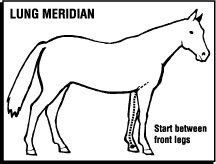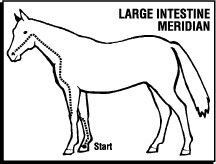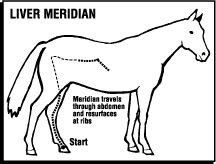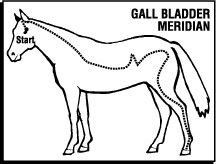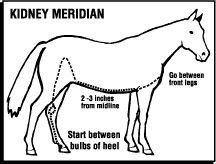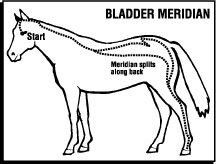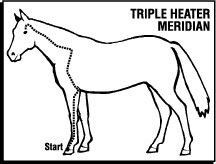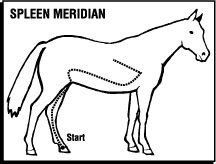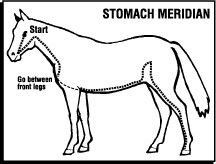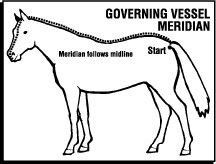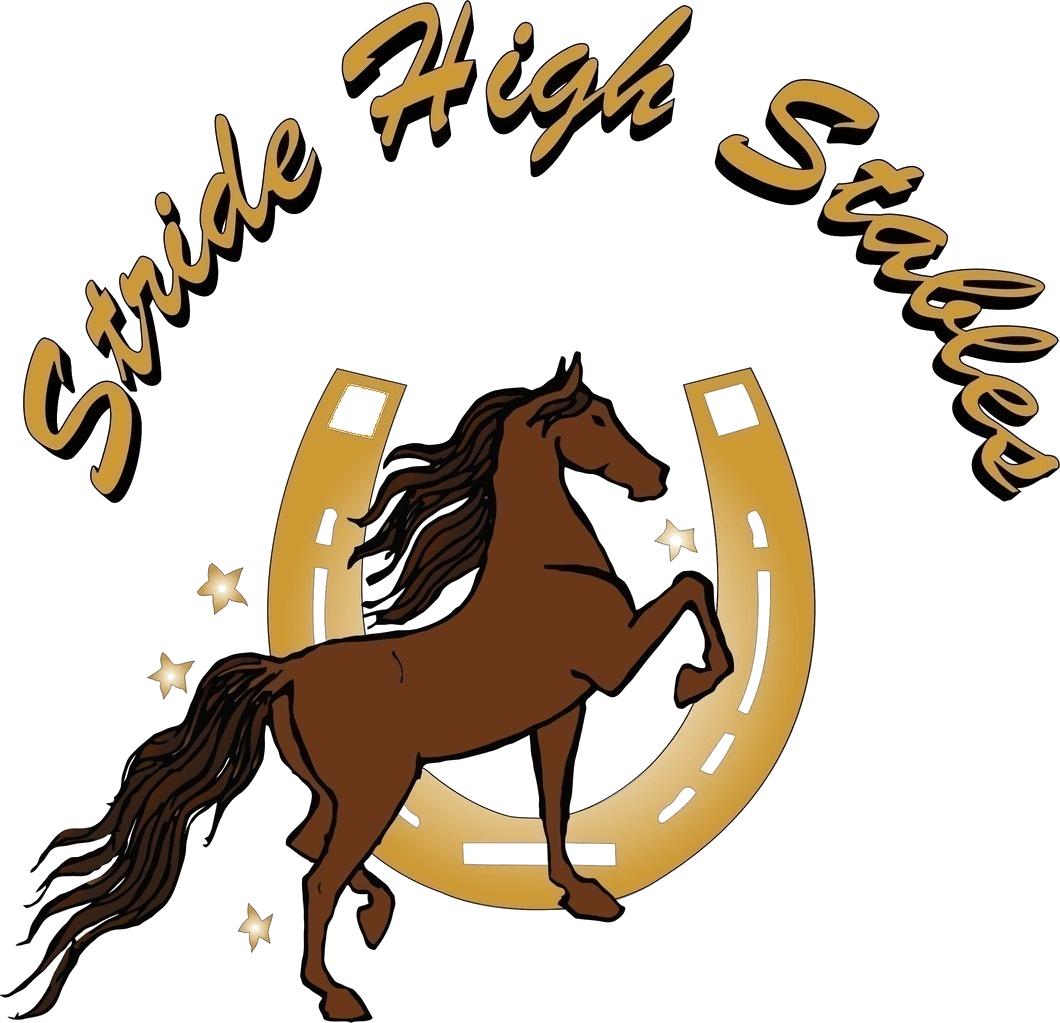MERIDIAN LINES & HORSES
MERIDIAN LINES & HORSES
Grab a friend. Each of you rub your hands together, then one of you hold your hands out in front of you palms up, the other palms down, about five inches above and below each other. Wait a moment, and be aware of the sensations traveling through the airspace between your hands. It may feel like soft pulsations, or mild static electricity, passing between you. Do you feel it?
That is what is known as Chi (pronounced chee), in Oriental terms, or the life force energy. This energy, magical, invisible, but real, consists of negative (Yin) and positive (Yang) polarities. It travels throughout the healthy body in an on-going and self-regulating balance, along energy pathways called meridians.
The meridian system balances Yin and Yang and keeps Chi moving; regulates conditions of excess and deficiency; resists external and internal disease-producing organisms; and indicates when there is disharmony and imbalance.
Along these meridians, which run close to the body surface, are located over 350 points known as acupuncture or acupressure points. These specific points, approximately the size of a dime, on the body surface can be stimulated to increase or decrease energy to restore balance and allow for healing. The stimulation can be done with fine needles as in acupuncture, with fingertip pressure as in acupressure, with lasers, and other techniques.
If there is a blockage of energy flow along a meridian, it causes an energy imbalance that results in problems and disease. How do energy blockages happen? Many factors are responsible. Injuries, toxins, trauma, overexertion, fear, stress, anxiety, harsh weather, and living conditions can all play a part.
Meridians are associated with internal organs, and a blockage of energy flow affects the function of the organs, and can lead to disease. A disease condition further reduces the body's ability to self-regulate its energy. With acupuncture and acupressure treatments, however, the energy imbalance can be corrected, and the body can reestablish its equilibrium and can recover.
The Meridian System
In the body, there are twelve meridians. They are paired up as shown as Yin and Yang couples to maintain balance of Chi. Each of these meridians is related to a specific organ system and has a paired meridian, with which it works together. If one of the two coupled meridians is treated, the other benefits as well. For example, the Heart meridian, a Yin, and the Small Intestine meridian, a Yang, are paired.
Heart
- circulation problems, heart disorders, restlessness, shortness of breath, shoulder problems, vision disorders, behavior problems
Small Intestine - shoulder and foreleg problems, laminitis, neck stiffness, gland problems, TMJ problems, colic, depression, lethargy
Lung
- respiratory problems; asthma, heaves, coughing; chest pain; knee problems; dry skin or dull coat
Large Intestine
- constipation, diarrhea, respiratory conditions, neck and shoulder problems, elbow problems, skin problems, weak immune system
Liver
- ligament, tendon, and joint problems, hoof, digestive, vision problems, estrous cycle irregularities, anger and aggression
Gall Bladder
- (horses don't have a gall bladder; the meridian name was carried over from humans) - used for joint, tendon and muscle problems, arthritic conditions, hind end problems, weakened immunity, eye problems, laminitis
Kidney
- infertility problems (mares and stallions) and estrous cycle irregularities, bone breaks and problems including joints, dental problems, founder, poor coat condition, weakened immunity, concentration problems, and lack of confidence
Bladder
- Urinary tract problems, lower back problems, arthritis and joint or bone problems, spasms and cramps of the hindquarters, hock problems, timidity and indecision
Pericardium
- respiratory and heart problems, anxiety disorders, problems involving the forelegs and forefeet
Triple Heater
- forefeet, foreleg, shoulder, and neck problems, ear problems, colic
Spleen
- weakened immunity and other immune disorders, weakened muscles, stifle and pelvis problems, stocking up, colic, diarrhea, digestive disorders, weight problems
Stomach
- colic, digestion problems, stifle disorders, hind end disorders, weakness and lethargy, TMJ tension and pain, eye problem
Two other important energy pathways travel along the midline of the body. They are:
The Conception Vessel
is linked to all the Yin meridians. As its name suggests, it has an influence on the reproductive systems, particularly the mare. It runs along the midline on the underside of the horse, from the anus to the lower lip.
Meridian tracing is a simple method in acupressure that allows one to begin to feel the energy and its flow through meridian line, and it has therapeutic value as well. The therapeutic value is not as great as specific point treatment, but tracing moves and stimulates the energy along the meridians, enhancing its flow. Tracing the meridians is also used to begin a treatment session, and end it. Tracing begins to release blocked energy, and increase circulation.
The Governing Vessel
is linked with all the Yang meridians and strengthens the body's Yang energy. It influences the brain and the spine. It runs along the midline on the horse's back, from the anus to the upper lip.
These energy pathways are not directly associated with the organs, but they act as overflow vessels to assist in balancing the highs and lows of energy in the twelve meridians when needed.
Meridian and point charts are a very useful guide, but due to the animals' individual differences, they cannot be exact in showing the precise locations for each meridian or point. One can develop a feel for the energy and do a more precise location using tactile senses. This is the most reliable way to locate them.
Getting the feel of it
Meridian tracing is a simple method in acupressure that allows one to begin to feel the energy and its flow through meridian line, and it has therapeutic value as well. The therapeutic value is not as great as specific point treatment, but tracing moves and stimulates the energy along the meridians, enhancing its flow. Tracing the meridians is also used to begin a treatment session, and end it. Tracing begins to release blocked energy, and increase circulation.
Get to know the paths of the meridians by tracing them. Keep a chart handy and refer to it as you go. With an open flat hand placed somewhere on the horse for connection, slide your tracing hand along the path of the meridian in the direction in which the energy flows. Both hands should remain in contact with the horse while this is being done, to keep a connection and to allow the energy to reroute back to the body. Be aware of sensations in your palms and fingers, and in your horse's skin, soft spots, firm spots, temperature changes, and others. Make mental notes of the location of these sensations.
If the energy cannot be felt this way, another way is to keep each hand about 4 to 5 inches away from the horse's body, and trace the meridians with air space between. A difference can be felt when an area of lesser or greater energy is encountered (the points). Watch also how your horse reacts to this without being touched - he will feel it too. By keeping the hands at these locations for a few seconds, the energy leveling can be felt. Watch the horse react to this as well. He may initially seem uncomfortable and attempt to move away, but as the energy balances out and he feels relief, he may take a deep breath or lick and chew. Energy leveling will help re-establish the proper flow of Chi, thus restoring the body's natural healing ability.
Indicators of an effective treatment include: points which were warm returning to normal body temperature and feel, points or areas of the body that were cool coming up to body temperature, a decrease of inflammation, a nervous or pained horse becoming calm and relaxed, body posture changes, and attitude adjustments. One's positive intent while doing any of the energy work also increases the beneficial effects of a treatment.
Alarm points and Association points
By utilizing the Alarm and Association points, one can determine which meridians need work most. Alarm points are specific points that, when painful or tender, indicate an organ problem. Alarm points are located on the underside of the horse, on or near the midline, on the abdomen and chest, and near a particular organ.
Association points are specific points that, when painful or tender, indicate a blockage in the corresponding meridian or a problem in the corresponding organ. Each association point is directly connected with an internal organ and a meridian; each of the twelve meridians has a unique association point. The Association points directly affect the organs and can strengthen the organ. The Association points are located on the back between the withers and the rump, along the Bladder meridian, which runs parallel to the spine.
Books for further information
Acupressure:
Equine Acupressure, A Working Manual
by Nancy Zidonis, Marie Soderberg, and Amy Snow
Equine Acupressure: First Aid With Your Fingertips; A Practical Workbook
by Ron and Linda Briel
Acupuncture:
Healing Your Horse
by Meredith Snader, VMD, Sharon Willoughby, DVM, DC, Deva Kaur Khalsa, VMD, Craig Denega, BA, and Ihor John Basko, DVM
The Treatment of Horses by Acupuncture
by Erwin Westermayer, DMV
Association points are used in conjunction with the Alarm points to diagnose and determine the depth of disturbance. Sensitivity in the Association point and the Alarm point usually means a problem in the meridian and the organ; sensitivity to the Association point but not the Alarm point usually means a problem in the meridian but not the organ. Sensitivity on light pressure (Yang) usually indicates an acute problem; sensitivity to deep pressure (Yin) usually indicates a chronic problem. A painful or sensitive response would be moving away from the touch or pressure, quivering of the muscle, ducking the back, or attempting to bite or kick.
Getting training
The success of acupuncture and acupressure depends upon the correct selection of points for treatment. While acupuncture must be performed by a professional, acupressure can be performed by anyone. With the hundreds of points involved, this may seem next to impossible to learn, but a good text, a course, or a practiced friend can help.
Courtesy of Natural Horse Magazine

